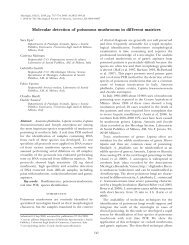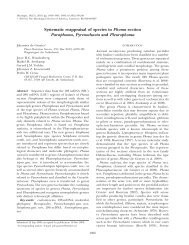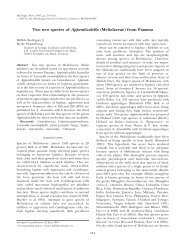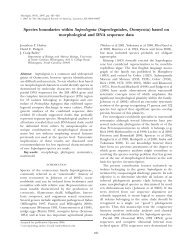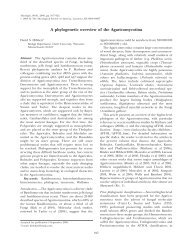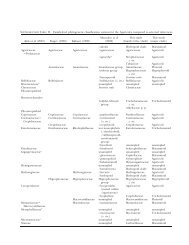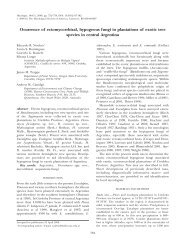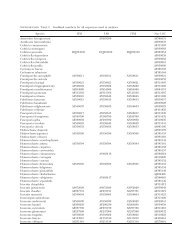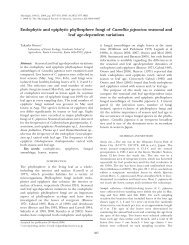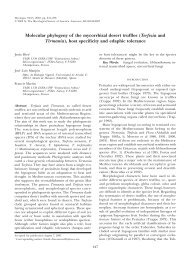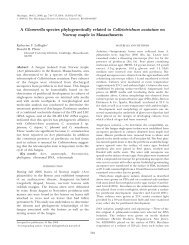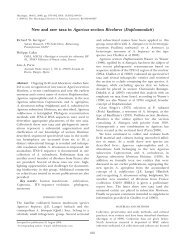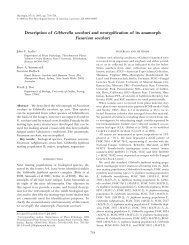The Entolomataceae of the Pakaraima Mountains of ... - Mycologia
The Entolomataceae of the Pakaraima Mountains of ... - Mycologia
The Entolomataceae of the Pakaraima Mountains of ... - Mycologia
You also want an ePaper? Increase the reach of your titles
YUMPU automatically turns print PDFs into web optimized ePapers that Google loves.
<strong>Mycologia</strong>, 102(3), 2010, pp. 633–649. DOI: 10.3852/09-162<br />
# 2010 by <strong>The</strong> Mycological Society <strong>of</strong> America, Lawrence, KS 66044-8897<br />
<strong>The</strong> <strong>Entolomataceae</strong> <strong>of</strong> <strong>the</strong> <strong>Pakaraima</strong> <strong>Mountains</strong> <strong>of</strong> Guyana IV:<br />
new species <strong>of</strong> Calliderma, Paraeccilia and Trichopilus<br />
M. Ca<strong>the</strong>rine Aime1 Department <strong>of</strong> Plant Pathology and Crop Physiology,<br />
Louisiana State University Agricultural Center,<br />
Baton Rouge, Louisiana 70803<br />
David L. Largent<br />
Terry W. Henkel<br />
Department <strong>of</strong> Biological Sciences, Humboldt State<br />
University, Arcata, California 95521<br />
Timothy J. Baroni<br />
Department <strong>of</strong> Biological Sciences, State University <strong>of</strong><br />
New York, College at Cortland, New York 13045<br />
Abstract: This paper is <strong>the</strong> fourth in a series<br />
documenting <strong>the</strong> <strong>Entolomataceae</strong> taxa (Agaricales,<br />
Basidiomycota) from Guyana. Six new species in three<br />
genera are described—Calliderma caeruleosplendens,<br />
Paraeccilia unicolorata, Trichopilus tibiiformis, T.<br />
fasciculatus, T. vividus, and T. luteolamellatus—<br />
occurring primarily in mixed tropical rainforests <strong>of</strong><br />
<strong>the</strong> Potaro River Basin in <strong>the</strong> <strong>Pakaraima</strong> <strong>Mountains</strong>.<br />
Macromorphological, micromorphological and habitat<br />
data are provided for each. None <strong>of</strong> <strong>the</strong>se genera<br />
had been reported from Guyana.<br />
Key words: Agaricomycotina, fungal systematics,<br />
Guayana Highlands, Guiana Shield, Neotropical<br />
fungi<br />
INTRODUCTION<br />
<strong>The</strong> <strong>Entolomataceae</strong> Kotl. & Pouzar is a cosmopolitan<br />
and species-rich family <strong>of</strong> Agaricales containing more<br />
than 1000 described species (Kirk et al. 2001). Species<br />
<strong>of</strong> <strong>Entolomataceae</strong> are easy to identify to family<br />
because all produce pink basidiospores that are<br />
angular at least in polar view. However members<br />
can be difficult to diagnose to genus and <strong>the</strong><br />
literature reflects varying generic concepts (e.g.<br />
Noordeloos 1987, Largent 1994). Molecular phylogenetics<br />
have yet to shed light on this situation;<br />
preliminary studies suggest that large traditional<br />
genera such as Entoloma (Fr.) P. Kumm. and Leptonia<br />
(Fr.) P. Kumm. are polyphyletic but have yet to<br />
resolve generic boundaries (e.g. Moncalvo et al. 2004,<br />
V. H<strong>of</strong>stetter pers comm). In Guyana intensive<br />
Submitted 29 Jun 2009; accepted for publication 17 Oct 2009.<br />
1 Corresponding author. E-mail: maime@agcenter.lsu.edu<br />
633<br />
sampling in <strong>the</strong> <strong>Pakaraima</strong> <strong>Mountains</strong> has uncovered<br />
a rich flora <strong>of</strong> Neotropical <strong>Entolomataceae</strong>, most <strong>of</strong><br />
which are undescribed species (e.g. Largent et al.<br />
2008a, b; Henkel et al. 2009). In our ongoing<br />
taxonomic studies <strong>of</strong> <strong>the</strong>se we follow Largent (1994)<br />
in recognizing 13 genera <strong>of</strong> <strong>Entolomataceae</strong> based on<br />
a combination <strong>of</strong> macro- and micromorphological<br />
characters. <strong>The</strong>se include Calliderma, Paraeccilia and<br />
Trichopilus, new species <strong>of</strong> which are described here.<br />
Romagnesi introduced Rhodophyllus section Calliderma<br />
to contain those species <strong>of</strong> <strong>Entolomataceae</strong><br />
that have a hymeniform pileipellis most commonly<br />
with a single layer <strong>of</strong> pileocystidia (Romagnesi 1974).<br />
Largent (1994) raised Calliderma (Romagn.) Largent<br />
to generic rank and provided <strong>the</strong> additional characteristics<br />
<strong>of</strong> a tricholomatoid stature, a pruinose,<br />
tomentose, velutinous, or rivulose pileus, and hymeniform<br />
pileipellis. Entolomatoid species with <strong>the</strong> suite<br />
<strong>of</strong> characters <strong>of</strong> Calliderma have been reported from<br />
Madagascar and central Africa (Romagnesi 1941,<br />
1956; Romagnesi and Gilles 1979), North America<br />
(Largent 1977, 1994), Indomalaya and Australasia<br />
(Horak 1980), Europe (Noordeloos 1992), <strong>the</strong> Lesser<br />
Antilles (Pegler 1983, Baroni pers obs) and South<br />
America (Dennis 1953, 1970; Horak 1983).<br />
Paraeccilia Largent was created to accommodate<br />
those species previously classified in Entoloma subgenus<br />
Claudopus section Undati (Romagn.) Noordeloos<br />
(Largent 1994). Species <strong>of</strong> Paraeccilia have an<br />
omphalinoid stature, a convex, densely appressed<br />
fibrillose pileus, externally incrusted pigmentation on<br />
<strong>the</strong> walls <strong>of</strong> <strong>the</strong> hyphae <strong>of</strong> at least <strong>the</strong> pileal trama and<br />
<strong>the</strong> pileipellis, and most lack clamp connections<br />
(Largent 1994). Paraeccilia species have been reported<br />
from North America including Alaska (Largent<br />
1994), and species classified by o<strong>the</strong>rs in Entoloma s.l.<br />
or Rhodophyllus with <strong>the</strong> characteristics <strong>of</strong> a Paraeccilia<br />
have been reported from Europe (Noordeloos<br />
1992), Chile (Horak 1977), New Zealand (Horak<br />
1973), Tasmania (Gates and Noordeloos 2007) and<br />
Java (Horak 1980, 2008). Paraeccilia rusticoides (Gillet)<br />
Largent (as Entoloma rusticoides [Gillet] Noordel.)<br />
has been reported from Argentina (Singer<br />
1969), and Eccilia fuscorufescens Speg. from Brazil<br />
likely represents a second South American Paraeccilia<br />
species (Pegler 1997).<br />
Species <strong>of</strong> Trichopilus (Romagn.) P.D. Orton are<br />
typically tricholomatoid in stature with a densely<br />
fibrillose to tomentose pileus and trichodermial
634 MYCOLOGIA<br />
pileipellis, <strong>the</strong> hyphae <strong>of</strong> which have an intracellular<br />
pigment. Cheilocystidia, when present, are clavate to<br />
lageniform and typically capitate or mucronate. <strong>The</strong><br />
basidiospore morphology is variable, occasionally 4–5or<br />
5–6-sided (e.g. section Parastaurospori Romagnesi<br />
and section Leptonidei [Fr.] Quél. in Romagnesi and<br />
Gilles 1979) or more typically 6–8-sided; clamp<br />
connections usually are present (Largent 1994;<br />
Noordeloos 1981, 1992; Romagnesi and Gilles<br />
1979). Trichopilus species or those <strong>of</strong> Entoloma s.l.<br />
or Rhodophyllus with characteristics <strong>of</strong> Trichopilus<br />
have been reported regularly from North America<br />
(Hesler 1967, Largent 1994), Europe (Noordeloos<br />
1992) and more rarely from New Zealand, Australasia,<br />
Indomalaya (Horak 1973, 1980) and <strong>the</strong> Ivory Coast<br />
(Romagnesi and Gilles 1979). As far as can be<br />
determined Trichopilus has not been reported from<br />
<strong>the</strong> Lesser Antilles (Pegler 1983), South America<br />
(Horak 1977, 1982) or elsewhere in <strong>the</strong> Neotropics.<br />
Herein we provide descriptions and illustrations <strong>of</strong><br />
six new species in Calliderma, Paraeccilia and Trichopilus:<br />
C. caeruleosplendens represents <strong>the</strong> first report <strong>of</strong><br />
this genus from Guyana; P. unicolorata is <strong>the</strong> first<br />
report <strong>of</strong> an entolomatoid species with decurrent gills<br />
and incrusted pigmentation from Guyana; four species<br />
<strong>of</strong> Trichopilus are reported for <strong>the</strong> first time in South<br />
America, T. tibiiformis, <strong>the</strong> first report <strong>of</strong> a South<br />
American entolomatoid species with tibiiform cystidia<br />
and three species with granulose-fibrillose pileus and<br />
stipe, T. fasciculatus with distinctive tufts <strong>of</strong> pileocystidia,<br />
T. luteolamellatus with yellow lamellae and flesh<br />
and T. vividus with vivid, nearly fluorescent colors.<br />
MATERIALS AND METHODS<br />
Methods for collection, field descriptions, microscopic<br />
analyses and image capture were those <strong>of</strong> Largent et al.<br />
(2008a). Color designations are according to Kornerup and<br />
Wanscher (1978); herbarium designations are according to<br />
Holmgren et al. (1990). Microscopic structures were<br />
measured as described by Largent (1994) and Largent et<br />
al. (2008a). Statistics include: x¯, <strong>the</strong> arithmetic means <strong>of</strong><br />
basidiospore length and width, 6 standard deviation; E, <strong>the</strong><br />
quotient <strong>of</strong> length by width indicated as a range variation in<br />
n objects measured; Q, <strong>the</strong> mean <strong>of</strong> E-values; L–D, <strong>the</strong><br />
length minus <strong>the</strong> diameter <strong>of</strong> basidiospores; and AL–D, <strong>the</strong><br />
average L–D; n/4 indicates <strong>the</strong> number <strong>of</strong> objects measured/per<br />
each collection studied.<br />
TAXONOMY<br />
Calliderma caeruleosplendens Largent, Aime et T.W.<br />
Henkel sp. nov. FIGS. 1a, 2<br />
MycoBank MB 513502<br />
Pileus 35–140 (diam.) 3 4–37 mm, late convexus ad<br />
plano-convexus, atrocaeruleus, dense implexo-tomentosus.<br />
Lamellae adnexae vel adnatae, pallidae. Stipes 39–90 3 4–<br />
24 mm, colore eodem modo ac in stipite vel pallidiore,<br />
longistrorsum implexo-appressus fibrillosus. Basidiosporae<br />
5–6-gonae, subisodiametrae, 7.8–10.1 3 5.5–9.2 mm. Basidia<br />
2–4-sterigmata, clavata basi angusta, 31.3–61.0 3 7.3–<br />
11.2 mm. Cheilocystidia typice carentia. Pleurocystidia carentia.<br />
Pileipellis hymeniformis, constrata e pileocystidiis<br />
unistratis. Pileocystidia clavata, napiformia vel late obclavata,<br />
11.5–51.6 3 2.8–21.7 mm. Stipitipellis constrata e dispersis<br />
fasciculis agglutinatarum hypharum. Caulocystidia clavata<br />
vel cylindro-clavata, 52.9–65.8 3 4.2–4.9 mm. Pigmentum<br />
solum in pileipelle et stipitipelle, solubile in 3% KOH.<br />
Fibulae praesentes.<br />
Stature tricholomatoid. Pileus 35–140 mm broad, 4–<br />
37 mm high; varying from broadly convex without an<br />
umbo to plano-convex with a broad, rounded umbo;<br />
dark blackish blue throughout in youth (19–22F6 to<br />
19–22F8), at maturity with a dark blackish blue<br />
margin, dark blue (21F4 or 22D4 or 24F4) disk, and<br />
moderately dark blue to blackish blue central region;<br />
densely matted-tomentose throughout, fibrils toward<br />
disk minutely erect under hand lens, at times radially<br />
rugose over inner 4/5, becoming rugulose at margin;<br />
submoist; <strong>of</strong>ten subsulcate over outer 3/5; margin<br />
slightly and regularly crenate when young, irregularly<br />
undulating with age, uprolled, <strong>of</strong>ten splitting to reveal<br />
whitish pileitrama. Pileal context <strong>of</strong>f-white; 4–13 mm<br />
thick over stipe; solid. Lamellae adnexed occasionally<br />
appearing free to adnate; 15 mm at broadest point;<br />
thick; close to subdistant; pale yellowish white to pink<br />
with basidiospore maturity, occasionally with bluish or<br />
purplish cast particularly on <strong>the</strong> edges in mature<br />
specimens; edges smooth; lamellulae <strong>of</strong> three tiers,<br />
much narrower than lamellae. Stipe 39–90 3 4–<br />
24 mm; frequently equal but at times enlarging<br />
toward <strong>the</strong> base, sometimes flaring slightly at apex;<br />
concolorous with <strong>the</strong> pileus but typically lighter, deep<br />
blue (19D–E6–8) to blue (21–22D–E4–5), <strong>the</strong> coloration<br />
originating from longitudinally oriented, superficial<br />
matted-appressed fibrils, extreme apex white;<br />
cartilaginous; dry; longitudinally striate-furrowed<br />
throughout; base <strong>of</strong> stipe with white tomentum,<br />
occasionally with whitish strigose hairs. Stipe context<br />
<strong>of</strong>f-white; fibrous, more or less solid. Odor mild,<br />
slightly fragrant or sweet; flavor slightly mealy to<br />
disagreeable. Macrochemical spot tests 10% NH4OH<br />
and 3% KOH negative on pileus; 3% KOH green on<br />
stipe base; 10% NH4OH and 3% KOH distinctly<br />
yellow on stipe flesh. Basidiospores 5–6-sided, distinctly<br />
angular but lacking protruding angles, not prismatic,<br />
isodiametric to heterodiametric, on average subisodiametric;<br />
7.8–10.1 3 5.5–9.2 mm, (x¯ 5 8.5 6 0.5 3<br />
7.0 6 0.5 mm, E 5 0.9–1.5, Q 5 1.2 6 0.07, L–D 0.0–<br />
3.4 mm, AL–D 1.30 6 0.5 mm; n/7 5 121). Basidia 2–4sterigmate;<br />
clavate, tapering downward toward a long,<br />
narrow base; sterigmata consistently to 4.0 mm long,
31.3–61.0 3 7.3–11.2 mm, (x¯ 5 48.4 6 3.6 3 9.3 6<br />
0.7 mm, E 5 3.3–7.6, Q 5 5.5 6 0.4; n/3 5 40).<br />
Cheilocystidia typically absent; in one collection (MCA<br />
1648) present but nearly indistinguishable from <strong>the</strong><br />
basidioles, colorless, found only in eroded areas on a<br />
few gill edges, 20.1–40.5 3 6.1–9.1 mm. Pleurocystidia<br />
absent. Lamellar trama hyphae similar to those in <strong>the</strong><br />
pileal trama at <strong>the</strong> top <strong>of</strong> <strong>the</strong> lamellae, more slender<br />
AIME ET AL.: NEW ENTOLOMATACEAE SPECIES 635<br />
FIG. 1. Basidiomata <strong>of</strong> new species <strong>of</strong> <strong>Entolomataceae</strong> from <strong>the</strong> <strong>Pakaraima</strong> <strong>Mountains</strong> <strong>of</strong> Guyana (bar 5 2.0 cm). a.<br />
Calliderma caeruleosplendens (T.W. Henkel 8804). b. Paraeccilia unicolorata (HOLOTYPE, T.W. Henkel 8723). c. Trichopilus<br />
fasciculatus (HOLOTYPE, M.C. Aime 2217). d. Trichopilus luteolamellatus (HOLOTYPE, M.C. Aime 1480). e. Trichopilus<br />
vividus (HOLOTYPE, M.C. Aime 1478).<br />
in <strong>the</strong> middle and edge <strong>of</strong> <strong>the</strong> lamellae, subparallel, in<br />
squash mounts <strong>of</strong> gill sections easily separated in <strong>the</strong><br />
lateral strata and subhymenium and thus appearing<br />
loosely branched and distinct from <strong>the</strong> central<br />
stratum; relatively short, 37.9–84.7 3 4.9–21.0 mm (E<br />
5 2.8–8.9, Q 5 5.2; n 5 11). Pileipellis hymeniform,<br />
composed <strong>of</strong> a single layer <strong>of</strong> pileocystidia along <strong>the</strong><br />
entire surface; subterminal cells typically not inflated
636 MYCOLOGIA<br />
FIG. 2. Photomicrographs, Calliderma caeruleosplendens. a. Basidiomata (HOLOTYPE, M.C. Aime 3127) (bar 5 2.0 cm). b.<br />
Basidia and basidioles (T.W. Henkel 8664) (bar 5 10 mm). c. Basidiospores (M.C. Aime 1648) (bar 5 10 mm). d. Section<br />
through pileal disk showing, from <strong>the</strong> top down, <strong>the</strong> pileipellis, pileal trama, subhymenium and hymenium (T.W. Henkel<br />
8664) (bar 5 50 mm). e. Pileocystidia (HOLOTYPE, M.C. Aime 3127) (bar 5 20 mm). f. Pileocystidia (T.W. Henkel 8664) (bar<br />
5 20 mm). g. Caulocystidia (M.C. Aime 1648) (bar 5 20 mm). h. Cross section through lower pileus showing, left to right,<br />
hymenium, subhymenium and broad hyphae in pileal trama (HOLOTYPE, M.C. Aime 3127) (bar 5 50 mm).
ut rarely so; hyphae <strong>of</strong> <strong>the</strong> subpellis loosely<br />
entangled and thus differentiated from <strong>the</strong> trama<br />
proper. Pileocystidia clavate, broadly clavate, napiform<br />
or very broadly obclavate; shorter cells found near <strong>the</strong><br />
disk, longer cells toward and at <strong>the</strong> margin, 11.5–51.6<br />
3 2.8–21.7 mm (x¯ 5 25.6 6 10.9 3 12.9 6 5.8 mm, E 5<br />
0.9–5.6, Q 5 1.5 6 0.6; n/3 5 47). Pileal trama loosely<br />
interwoven throughout; individual hyphal cells 36.3–<br />
264.7 3 18.08–31.0 mm (E5 1.8–8.5, Q 5 4.8; n 5<br />
11). Stipitipellis composed <strong>of</strong> scattered clumps or<br />
clusters <strong>of</strong> agglutinated hyphae. Caulocystidia clavate<br />
to cylindro-clavate, somewhat sinuous and capitate in<br />
a few; 52.9–65.8 3 4.2–4.9 mm. Stipititrama hyphae<br />
more or less parallel to subparallel and slightly<br />
entangled. Refractive hyphae scattered in <strong>the</strong> stipititrama,<br />
scattered to abundant in <strong>the</strong> pileal trama,<br />
particularly evident immediately below <strong>the</strong> pileipellis.<br />
Pigmentation restricted to <strong>the</strong> pileipellis and <strong>the</strong><br />
stipitipellis, cytoplasmic in <strong>the</strong> pileocystidia, soluble<br />
and exuding in 3% KOH, visible for up to 10 min in<br />
water sections. Clamp connections small and difficult<br />
to discern, present at <strong>the</strong> base <strong>of</strong> <strong>the</strong> basidia, and on<br />
hyphae <strong>of</strong> <strong>the</strong> lamellar trama, subhymenium, stipititrama,<br />
pileipellis, and stipitipellis.<br />
Holotype. M.C. Aime 3127 (BRG; ISOTYPE LSUM).<br />
Habit, habitat and distribution. Common, solitary<br />
on humus or scattered on earth, in mixed tropical<br />
forest <strong>of</strong> <strong>the</strong> Eschweilera-Licania association and in<br />
forests dominated by Dicymbe corymbosa Spruce ex<br />
Benth. (Caesalpiniaceae, tribe Amherstieae); fruiting<br />
during <strong>the</strong> May–July rainy season and into August;<br />
known from <strong>the</strong> type locality in <strong>the</strong> Upper Potaro<br />
River Basin in <strong>the</strong> <strong>Pakaraima</strong> <strong>Mountains</strong> <strong>of</strong> Guyana<br />
and from <strong>the</strong> adjacent Ireng River Basin.<br />
Etymology. Caerule, splendens (Latin), referring to<br />
<strong>the</strong> splendid blue <strong>of</strong> <strong>the</strong> pileus and stipe.<br />
Specimens examined. GUYANA. Region 8 Potaro-Siparuni.<br />
<strong>Pakaraima</strong> <strong>Mountains</strong>, Upper Potaro River Basin, ,<br />
20 km east <strong>of</strong> Mount Ayanganna, environs <strong>of</strong> base camp on<br />
Potaro River 1 km upstream from confluence <strong>of</strong> Whitewater<br />
Creek at 5u18904.8N, 59u54940.4W, 710–750 m. In Dicymbe<br />
forest upstream from base camp, 5 Jun 2000, M.C. Aime<br />
1125 (BRG, LSUM); vicinity <strong>of</strong> base camp, 18 May 2001,<br />
M.C. Aime 1467 (BRG, LSUM); in mixed plot 1, 16 May<br />
2001, T.W. Henkel 8158 (BRG, HSU); in mixed plot 2, 27<br />
May 2001, M.C. Aime 1648 (BRG, LSUM); vicinity <strong>of</strong> base<br />
camp, 10 Jun 2001, M.C. Aime 1852 (BRG, LSUM); mixed<br />
plot 2, 24 Jun 2001, T.W. Henkel 8367 (BRG, HSU); mixed<br />
plot 1, 9 Jun 2004, T.W. Henkel 8664 (BRG, HSU); 1 km SW<br />
<strong>of</strong> base camp in Dicymbe forest, 28 May 2005, T.W. Henkel<br />
8804 (BRG, HSU); Lance plot 1, east <strong>of</strong> Benny’s Ridge in<br />
Dicymbe forest, 29 Jun 2006, M.C. Aime 3127 (HOLOTYPE<br />
BRG, ISOTYPE LSUM); vicinity <strong>of</strong> base camp, 17 Aug 2007,<br />
T.W. Henkel 8871, (BRG, HSU).<br />
Commentary. Calliderma caeruleosplendens can be<br />
identified by its dark blackish blue and densely<br />
AIME ET AL.: NEW ENTOLOMATACEAE SPECIES 637<br />
matted-tomentose pileus, pale whitish lamellae that<br />
turn pink, dark blue stipe that is slightly lighter than<br />
<strong>the</strong> pileus, 5–6-sided, subisodiametric basidiospores,<br />
and cylindro-clavate and sinuous caulocystidia. In<br />
addition C. caeruleosplendens has distinctive macrochemical<br />
reactions with 3% KOH (green on stipe base;<br />
yellow on stipe flesh) and 10% NH 4OH (yellow on<br />
stipe flesh). Calliderma caeruleosplendens has been<br />
found to fruit consistently over 8 y during <strong>the</strong> May–<br />
July rainy season <strong>of</strong> <strong>the</strong> Potaro River Basin. Its large<br />
stature and blue pigment distinguish it as one <strong>of</strong> <strong>the</strong><br />
more distinctive and easily recognizable macr<strong>of</strong>ungi<br />
found in that area.<br />
Several described entolomatoid species with blackish<br />
blue pileus, blue stipe and a hymeniform<br />
pileipellis might be confused with C. caeruleosplendens.<br />
Leptonia howellii (Peck) Dennis possesses deep<br />
blue coloration and a tomentose pileus and is known<br />
from adjacent Venezuela (Dennis 1970, Largent<br />
1977). However L. howellii has a smaller, conic to<br />
convex pileus (10–20 mm vs. 35–140 mm broad), a<br />
stipe that is narrower at <strong>the</strong> apex (1–2 mm vs. 4–<br />
24 mm), larger basidiospores (10–13 3 6.5–8.0 mm vs.<br />
7.8–10.1 3 5.5–9.2 mm), and a pileipellis composed <strong>of</strong><br />
agglutinated clusters <strong>of</strong> hyphae with short, clavate<br />
pileocystidia. Leptonia caeruleocapitata (Dennis) Pegler<br />
from <strong>the</strong> Lesser Antilles and Venezuela (Dennis<br />
1970, Pegler 1983) also can be differentiated by its<br />
smaller basidioma (19–20 mm broad pileus and 2–<br />
3 mm broad stipe), white pileal margin, pungent,<br />
metallic or slightly farinaceous odor, and 6–8-sided,<br />
isodiametric basidiospores with rounded angles.<br />
Calliderma indig<strong>of</strong>era (Ellis) Largent from <strong>the</strong> eastern<br />
USA can be distinguished by its sinuate, emarginate<br />
white lamellae, white stipe that is only tinged blue,<br />
smaller basidiospores (7–8 3 6.5–7.5 mm), lack <strong>of</strong><br />
caulocystidia, and large, pseudoclamp-like clamp<br />
connections (Largent 1994). Rhodophyllus callidermus<br />
Romagn. from Zaire, Madagascar, Gabon and <strong>the</strong><br />
Ivory Coast can be separated from C. caeruleosplendens<br />
by its smaller pileus (35–75 mm broad 3 6–110 mm<br />
high) becoming brownish with age, lack <strong>of</strong> yellow<br />
coloration in <strong>the</strong> lamellae, weakly reddish macrochemical<br />
reaction to 10% NH4OH, smaller basidiospores<br />
(6.5–8.5 3 5.7–8.0 mm) and smaller basidia<br />
(30–38 3 10–11.5 mm) (Romagnesi 1941, Romagnesi<br />
and Gilles 1979).<br />
Several Asian species with blue pilei, tricholomatoid<br />
statures and a hymeniform pileipellis have been<br />
described. Entoloma burkillii Massee from Singapore,<br />
Malaysia and Papua New Guinea is easily distinguished<br />
from C. caeruleosplendens by <strong>the</strong> former’s<br />
glabrous pileus, white to pallid gray stipe, and<br />
cylindrical, narrow pileocystidia. Entoloma divum<br />
Corner and E. Horak from Malaysia can be distin-
638 MYCOLOGIA<br />
guished by its slender stipe (5–7 mm broad at <strong>the</strong><br />
apex), cylindrical to narrowly fusoid pileocystidia, and<br />
narrower, heterodiametric, 5–7-sided basidiospores<br />
(Horak 1980). Entoloma marinum Corner & E. Horak<br />
from Singapore and E. simillimum Corner & E. Horak<br />
from Malaysia and Singapore (Horak 1980) can be<br />
separated by <strong>the</strong>ir abundant, vesiculose to broadly<br />
clavate (in E. simillimum) or fusoid (in E. marinum)<br />
cheilocystidia and smaller basidiospores (6.5–8 3 6.0–<br />
6.5 mm and 7–8 3 5.5–6.5 mm respectively vs. 7.8–10.1<br />
3 5.5–9.2 mm inC. caeruleosplendens).<br />
Horak (1983) described two new species from<br />
South America that he classified into Entoloma section<br />
Callidermi, Entoloma peculiare E. Horak & Corner<br />
from Brazil and E. pruinatum E. Horak from<br />
Argentina. Nei<strong>the</strong>r species is similar to C. caeruleosplendens<br />
given <strong>the</strong>ir fuliginous or fuscous pilei,<br />
collybioid stature with up to 12 mm broad pileus<br />
and up to 1 mm diam stipe, and absence <strong>of</strong> clamp<br />
connections.<br />
Paraeccilia unicolorata Largent et T.W. Henkel sp.<br />
nov. FIGS. 1b, 3<br />
MycoBank MB 513503<br />
Pileus 21–31 mm diam, irregulariter convexus, atrobrunneus,<br />
minute pustulatus. Lamellae decurrentes ad<br />
subdecurrentes, colore eodem modo ac in pileo. Stipes<br />
38–68 3 3.5–6.0 mm, aequus vel subbulbosus, colore eodem<br />
modo ac in pileo sed longitudine brunneo-griseo-striatus.<br />
Basidiosporae 5–6-gonae, subisodiametrae vel heterodiametrae,<br />
8.3–10.6 3 6.9–9.0 mm. Basidia 2–4-sterigmata, plus<br />
minusve clavata sed parallelis lateribus, 30.6–42.5 3 6.9–<br />
11.6 mm. Cheilocystidia abundantia, cylindro-clavata, 29.8–<br />
92.8 3 5.8–8.2 mm, sine pigmento. Pleurocystidia abundantia,<br />
clavata vel cylindrico-clavata, 28.5–42.3 3 6.9–12.1 mm,<br />
pallido porphyreo pigmento in cytoplasmate. Pileipellis<br />
constrata e laxe intricato vallo cellularum terminalium.<br />
Pileocystidia cylindro-clavata, similia cheilocystidiorum,<br />
19.2–88.2 3 6.2–12.0 mm. Caulocystidia similia cheilocystidiorum,<br />
37.2–130.4 3 6.2–13.2 mm. Pigmentum valde<br />
incrustatum in totis telis praeter hymenialia cystidia. Fibulae<br />
carentes.<br />
Stature omphalinoid. Pileus 21–31 mm broad;<br />
irregularly convex; chocolate brown to teak brown<br />
(6F4–6F5) throughout, with a slight, light cinnamon<br />
brown (6D6) central depression; minutely pustulose,<br />
glabrous when fresh, felty-fibrillose in dried specimens;<br />
not hygrophanous; pileal cuticle up to 1 mm<br />
thick, concolorous with <strong>the</strong> pileal surface; pileal<br />
margin decurved to incurved, entire, not translucent.<br />
Pileal context <strong>of</strong>f-white, up to 1mm thick at <strong>the</strong><br />
margin, 2 mm thick at stipe attachment, extending<br />
5–7 mm radially. Lamellae decurrent to subdecurrent;<br />
8.75–16 mm long, up to 4 mm high; narrow; close;<br />
concolorous with pileus; somewhat sericeous due to<br />
pleuro- and cheilocystidia that are visible with 103<br />
hand lens; lamellulae 3–5 between lamellae, 1.5–<br />
6.0 mm long, in 2 (2 short, 1 medium) to 3 (2 short, 2<br />
medium, 1 medium long) tiers. Stipe 38–68 3 3.5–<br />
6.0 mm; even to subbulbous; slightly flattened,<br />
cartilaginous; dry; concolorous with pileus but appearing<br />
sericeous due to brownish gray (6E2)<br />
longitudinal striations; with a white felt-like basal<br />
tomentum. Stipe context hollow, filamentous near <strong>the</strong><br />
stipitipellis except at <strong>the</strong> base; basal context threelayered,<br />
white, <strong>the</strong>n concolorous with <strong>the</strong> stipe<br />
surface, <strong>the</strong>n white in tomentum. Odor slightly<br />
spermatic; flavor mild becoming slightly bitter.<br />
Basidiospores 5–6-sided in pr<strong>of</strong>ile and face views, 4–5sided<br />
in apical view; distinctly angular, not prismatic,<br />
subisodiametric to heterodiametric; 8.3–10.6 3 6.9–<br />
9.0 mm, (x¯ 5 9.4 6 0.5 3 7.8 6 0.6 mm, E 5 1.0–1.3, Q<br />
5 1.2 6 0.1, L–D 0.4–2.7 mm, AL–D 1.7 6 0.5 mm; n 5<br />
26). Basidia 2–4-sterigmate; more or less clavate but<br />
with parallel sides and not significantly tapered at <strong>the</strong><br />
base; 30.6–42.5 3 6.9–11.6 mm (x¯ 5 37.8 6 3.2 3 9.8<br />
6 1.4 mm, E 5 2.9–5.3, Q 5 3.9 6 0. 6; n 5 12).<br />
Cheilocystidia abundant, forming a sterile layer on <strong>the</strong><br />
gill edge originating as terminal cells <strong>of</strong> <strong>the</strong> hyphae <strong>of</strong><br />
<strong>the</strong> gill trama; cylindro-clavate with undulating sides;<br />
hyaline; 29.8–92.8 3 5.8–8.2 mm. Pleurocystidia abundant<br />
as pseudocystidia originating from <strong>the</strong> inner<br />
portion <strong>of</strong> <strong>the</strong> subhymenium; clavate to cylindroclavate;<br />
with a light reddish brown cytoplasmic<br />
pigment throughout; 28.5–42.3 3 6.9–12.1 mm, (x¯ 5<br />
34.6 6 4.1 3 8.7 6 1.6 mm; E 5 2.9–5.2, Q 5 4.1 6<br />
0.5; n 5 16). Lamellar trama hyphae parallel and with<br />
incrusting pigment, 50.4–119.6 3 4.5–11.8 mm. Pileipellis<br />
a loosely entangled palisade <strong>of</strong> pileocystidia;<br />
subpellis a densely interwoven layer. Pileocystidia<br />
similar in shape to cheilocystidia, cylindro-clavate,<br />
faintly strangulated and undulating; typically not<br />
pigmented; 19.2–88.2 3 6.2–12.0 mm. Pileal trama<br />
hyphae entangled, 68.5–168.3 3 7.0–10.8 mm,<br />
interspersed with scattered, large refractive hyphae.<br />
Stipitipellis composed <strong>of</strong> abundant clusters <strong>of</strong><br />
caulocystidia. Caulocystidia similar in shape to,<br />
but usually on <strong>the</strong> average longer than, <strong>the</strong><br />
cheilocystidia; not pigmented; 37.2–130.4 3 6.2–<br />
13.2 mm. Refractive hyphae scattered in <strong>the</strong> pileal<br />
trama. Pigmentation heavily incrusted on <strong>the</strong><br />
hyphae <strong>of</strong> <strong>the</strong> gill trama, pileal trama, stipititrama<br />
and subpellis <strong>of</strong> <strong>the</strong> pileipellis, occasionally incrusted<br />
on a few pileocystidia but appearing<br />
cytoplasmic in most; cytoplasmic and light reddish<br />
brown in 3% KOH in <strong>the</strong> pleurocystidia. Clamp<br />
connections absent on all tissues.<br />
Holotype. T.W. Henkel 8723 (BRG; ISOTYPE HSU).<br />
Habit, habitat and distribution. Scattered and infrequent<br />
on mineral soil in mixed rainforest <strong>of</strong> <strong>the</strong><br />
Eschweilera-Licania association during <strong>the</strong> May–July
AIME ET AL.: NEW ENTOLOMATACEAE SPECIES 639<br />
FIG. 3. Photomicrographs, Paraeccilia unicolorata (HOLOTYPE, T.W. Henkel 8723). a and b. Basidiospores (bar 5 10 mm).<br />
c. Cheilocystidia (bar 5 50 mm). d. Lamellar section showing pigmented trama, hymenium and cheilocystidia (bar 5 50 mm). e.<br />
Origin <strong>of</strong> pleurocystidia (bar 5 30 mm). f. Pileocystidia (bar 5 10 mm). g. Caulocystidia at stipe apex (bar 5 10 mm). h.<br />
Externally incrusted hyphae and refractive hyphae in pileal trama (bar 5 20 mm). i. Basidia (bar 5 20 mm). j. Pileipellis near<br />
disk (bar 5 50 mm).
640 MYCOLOGIA<br />
rainy season. Known only from <strong>the</strong> type locality in <strong>the</strong><br />
Upper Potaro River Basin <strong>of</strong> Guyana.<br />
Etymology. Uni, color (Latin), referring to <strong>the</strong> single<br />
uniform color <strong>of</strong> <strong>the</strong> pileus, stipe, and lamellae.<br />
Specimens examined. GUYANA. Region 8 Potaro-Siparuni.<br />
<strong>Pakaraima</strong> <strong>Mountains</strong>, Upper Potaro River Basin,<br />
, 20 km east <strong>of</strong> Mount Ayanganna, environs <strong>of</strong> base camp<br />
on Potaro River 1 km upstream from confluence <strong>of</strong><br />
Whitewater Creek at 5u18904.8N, 59u54940.4W, 710–750 m.<br />
In mixed plot 3, 30 Jun 2004, T.W. Henkel 8723<br />
(HOLOTYPE BRG; ISOTYPE HSU).<br />
Commentary. P. unicolorata is recognized macroscopically<br />
by its omphalinoid stature and dark graybrown<br />
basidiomata with decurrent gills reminiscent <strong>of</strong><br />
a species <strong>of</strong>Rhodocybe Maire. However <strong>the</strong> basidiospores<br />
<strong>of</strong> P. unicolorata are 4–5-angled and lack <strong>the</strong><br />
characteristic pustulate ornamentation <strong>of</strong> Rhodocybe<br />
basidiospores. In addition <strong>the</strong> strongly incrusted<br />
pigmentation found throughout <strong>the</strong> basidiomata and<br />
lack <strong>of</strong> clamp connections refer this taxon to<br />
Paraeccilia. O<strong>the</strong>r distinguishing microscopic characters<br />
include embedded pleurocystidia, a suprapellis<br />
composed <strong>of</strong> a palisade <strong>of</strong> terminal cells over a densely<br />
interwoven subpellis and sinuous cylindro-clavate<br />
pileocystidia that are similar in shape to <strong>the</strong> cheiloand<br />
caulocystidia. No o<strong>the</strong>r species <strong>of</strong> Guyanese<br />
entolomatoid fungi possess this combination <strong>of</strong><br />
characters.<br />
Paraeccilia unicolorata has some superficial characteristics<br />
that make it reminiscent <strong>of</strong> Entoloma<br />
fumosifolium Hesler from Tennessee (Hesler 1967),<br />
which is <strong>the</strong> type species <strong>of</strong> Entoloma section Fibropilus<br />
Noordeloos (Noordeloos 1988) (5 Fibropilus [Noordeloos]<br />
Largent [Largent 1994]). Both species share<br />
<strong>the</strong> features <strong>of</strong> dark brown basidioma, matted<br />
fibrillose, non-hygrophanous pileus, decurrent lamellae,<br />
long fibrillose stipe, subiso- or heterodiametric<br />
basidiospores, cylindro-clavate cheilo- and pileocystidia<br />
and incrusting pigmentation. However E. fumosifolium<br />
differs from P. unicolorata in its distinctly<br />
clitocyboid stature, larger pileus (30–60 mm vs. 21–<br />
31 mm), thicker stipe (5–10 mm vs. 3.5–6.0 mm<br />
broad), smaller basidiospores (8.0 3 6.0 mm vs. 9.4 3<br />
7.8 mm), lack <strong>of</strong> pleurocystidia, subfarinaceous odor,<br />
sweetish flavor, and most important by <strong>the</strong> presence<br />
<strong>of</strong> clamp connections in <strong>the</strong> lamellar trama that are<br />
characteristic for Fibropilus but typically lacking in<br />
Paraeccilia (Largent 1994).<br />
<strong>The</strong> basidioma color and decurrent lamellae <strong>of</strong> P.<br />
unicolorata also can be found in <strong>the</strong> illustrations <strong>of</strong> E.<br />
undatum (Fr.) M.M. Moser by Noordeloos (1992), a<br />
species found throughout Europe, and in P. perundata<br />
(Largent & B.L. Thomps.) Largent from Idaho<br />
and California. However Entoloma undatum s. Noordeloos<br />
can be separated from P. unicolorata by <strong>the</strong><br />
presence <strong>of</strong> clamps and lack <strong>of</strong> cheilo- and pleurocystidia<br />
(Noordeloos 1992). <strong>The</strong> deeply umbilicate,<br />
hygrophanous mature pileus, pale brown to yellow<br />
stipe 10–30 mm long, and pileipellis that is a cutis also<br />
distinguish <strong>the</strong> former from <strong>the</strong> latter. Paraeccilia<br />
perundata can be separated by its hygrophanous,<br />
infundibuliform mature pileus, much smaller stipe<br />
(6–20 mm long), smaller basidiospores up to 6.5 mm<br />
wide, cuticular pileipellis, lack <strong>of</strong> pleurocystidia and<br />
clamped basidia (Largent 1994).<br />
Eccilia rusticoides Gillet, reported from Argentina<br />
by Singer (1969) and E. fuscorufescens Speg. from<br />
Brazil share <strong>the</strong> features <strong>of</strong> decurrent lamellae and<br />
brown basidiomata with P. unicolorata. Eccilia rusticoides,<br />
like P. unicolorata, has an omphalinoid stature<br />
and externally incrusting pigment, which prompted<br />
<strong>the</strong> transfer <strong>of</strong> this species to Paraeccilia by Largent<br />
(1994). However E. rusticoides can be distinguished<br />
from P. unicolorata by <strong>the</strong> lack <strong>of</strong> hymenial cystidia<br />
and presence <strong>of</strong> isodiametric basidiospores in <strong>the</strong><br />
former (Largent 1994). Eccilia fuscorufescens, unlike<br />
P. unicolorata, is reddish brown with a finely striate,<br />
umbilicate pileus, slender stipe (1–2 mm diam), and<br />
lacks hymenial cystidia. Due to a lack <strong>of</strong> material<br />
available for examination <strong>of</strong> E. fuscorufescens (see<br />
Horak 1977) it is not possible to compare pigmentation<br />
in <strong>the</strong> basidioma and pileipellis, but it is possible<br />
that this taxon too represents a species <strong>of</strong> Paraeccilia.<br />
In <strong>the</strong> eastern hemisphere only Entoloma choanomorphum<br />
G.M. Gates & Noordel. from Tasmania and<br />
E. crinitum E. Horak and E. rancidulum E. Horak<br />
from New Zealand are morphologically similar to P.<br />
unicolorata. While all four share <strong>the</strong> features <strong>of</strong> dark<br />
brown pileus and omphalinoid stature, E. choanomorphum<br />
is readily separated by larger basidiospores (10–<br />
14 3 8–11 mm), larger, lageniform cheilocystidia (40–<br />
100 3 6–12 3 2–5 mm), and strong odor <strong>of</strong> sulfur or<br />
burnt rubber (Gates and Noordeloos 2007). <strong>The</strong> two<br />
species from New Zealand are differentiated from P.<br />
unicolorata by <strong>the</strong>ir isodiametric basidiospores and<br />
lack <strong>of</strong> hymenial cystidia (Horak 1973, 2008).<br />
Trichopilus tibiiformis Largent et Aime sp. nov. FIG. 4<br />
MycoBank MB 513504<br />
Pileus 18 mm diam, planus, lateritius, hirtis atro-brunneopurpureis<br />
fibrillis. Lamellae adnate, angustae, confertae,<br />
albae. Stipes 34 3 2 mm apice, aurantio-cinereus, glaber,<br />
cavus. Basidiosporae 5–6-gonae, typice heterodiametrae, 7.6–<br />
9.8 3 4.5–6.7 mm. Basidia 2–4-sterigmatae, clavatae et<br />
angustatae, 30.8–39.5 3 9.4–11.5 mm. Cheilocystidia abundantia,<br />
capitata, tubiformia vel anguste lecythiformia,<br />
leptocystidia, 29.2 3 40.6 3 2.5 3 8.2 mm. Pleurocystidia<br />
carentia. Pileipellis constrata e intricato trichodermio<br />
insidens disco, repens circa discum. Pileocystidia cylindroclavata,<br />
36.4–221.5 3 9.1–16.8 mm. Stipitipellis: cutis.
Pigmentum uniformiter cytoplasmicum et solum in pileipelle.<br />
Fibulae carentes.<br />
Pileus 18 mm broad; plane but with a broad, low,<br />
flat umbo; ground color a grayish red (8B3) with<br />
shaggy, dark violet-brown (10–11F5) fibrils covering<br />
disk from which <strong>the</strong> fibrils radiate outward; dry. Pileal<br />
context hyaline, 1 mm thick at disk. Lamellae adnatetoo<strong>the</strong>d;<br />
narrow, 1.5 mm at broadest point; close;<br />
white at first becoming pale pink (6A2) with<br />
basidiospore maturity. Stipe 34 3 2 mm at apex to<br />
3.5 mm wide at base; orange-gray (6B2) except for <strong>the</strong><br />
white base; glabrous; cartilaginous; basal tomentum<br />
absent. Stipe context fistulose. Odor none; flavor not<br />
noted. Basidiospores 5–6-sided in pr<strong>of</strong>ile, face and<br />
apical views, angles distinct except for <strong>the</strong> typically<br />
rounded apex, subheterodiametric to heterodiametric<br />
(not prismatic); 7.6–9.8 3 4.5–6.7 mm, (5x¯<br />
8.5 6 0.7 3 5.5 6 0.5 mm, E 5 1.4–1.8, Q 5 1.9 6 0.1,<br />
L–D 2.2–4.1 mm, AL–D 3.0 6 0.5 mm; n 5 34). Basidia<br />
2–4-sterigmate; clavate and tapered; 30.8–39.5 3 9.4–<br />
AIME ET AL.: NEW ENTOLOMATACEAE SPECIES 641<br />
FIG. 4. Trichopilus tibiiformis (HOLOTYPE, M.C. Aime 2426). a. Basidioma (bar 5 10 mm). b. Pileipellis on disk (bar 5<br />
100 mm). c. Basidiospores (bar 5 10 mm). d. Basidia and cheilocystidia (bar 5 30 mm).<br />
11.5 mm(x¯ 5 34.4 6 2.3 3 10.2 6 0.5 mm; E 5 2.9–4.0,<br />
Q 5 3.8 6 0.2; n 5 13). Cheilocystidia abundant and<br />
more or less forming a sterile gill edge <strong>of</strong> capitate,<br />
tibiiform to narrowly lecythiform leptocystidia; 29.2–<br />
40.6 3 2.5–8.2 mm. Pleurocystidia absent. Lamellar<br />
trama hyphae 71.8–158.5 3 5.4–14.2 mm. Pileipellis a<br />
slightly entangled layer <strong>of</strong> hyphae, <strong>the</strong>se generally<br />
erect at least on <strong>the</strong> disk, thus nearly an entangled<br />
trichodermium, more repent away from <strong>the</strong> disk.<br />
Pileocystidia cylindro-clavate; 36.4–221.5 3 9.1–<br />
16.8 mm. Stipitipellis a cutis; caulocystidia or hymenial<br />
clusters absent. Refractive hyphae rare in <strong>the</strong> stipititrama,<br />
absent elsewhere. Pigmentation restricted to<br />
<strong>the</strong> pileipellis and uniformly cytoplasmic, exuding<br />
into water mounts. Clamp connections absent on all<br />
tissues.<br />
Holotype. M.C. Aime 2426 (BRG; ISOTYPE LSUM).<br />
Habit, habitat and distribution. Solitary on humus in<br />
mixed tropical forest <strong>of</strong> <strong>the</strong> Eschweilera-Licania association<br />
during <strong>the</strong> December–January rainy season.
642 MYCOLOGIA<br />
Known only from <strong>the</strong> type locality in <strong>the</strong> Upper Potaro<br />
River Basin <strong>of</strong> Guyana.<br />
Etymology. Tibiiformis (Latin), referring to <strong>the</strong> tibiiform<br />
cheilocystidia.<br />
Specimen examined. GUYANA. Region 8 Potaro-Siparuni.<br />
<strong>Pakaraima</strong> <strong>Mountains</strong>, Upper Potaro River Basin,<br />
, 20 km east <strong>of</strong> Mount Ayanganna, environs <strong>of</strong> base camp<br />
on Potaro River 1 km upstream from confluence <strong>of</strong><br />
Whitewater Creek at 5u18904.8N, 59u54940.4W, 710–750 m.<br />
In mixed plot 1, 3 Jan 2004, M.C. Aime 2426 (HOLOTYPE<br />
BRG; ISOTYPE LSUM).<br />
Commentary. Trichopilus tibiiformis is known from a<br />
single collection <strong>of</strong> a single fruit body found during<br />
<strong>the</strong> shorter (December–January) rainy season in <strong>the</strong><br />
<strong>Pakaraima</strong> <strong>Mountains</strong>. However this species is distinct<br />
from all o<strong>the</strong>r Guyanese entolomatoid fungi due to its<br />
combination <strong>of</strong> small, delicate basidioma, pileus with<br />
shaggy, dark reddish brown fibrils on a lighter brown<br />
background, long cylindro-clavate pileocystidia, 5–6sided<br />
basidiospores reaching 10 3 7.0 mm, and<br />
capitate, tibiiform cheilocystidia.<br />
Few entolomatoid taxa could be confused with T.<br />
tibiiformis. A few described species—Entoloma mariae<br />
G. Stev. from New Zealand, and Rhodophyllus<br />
capitatus Romagn. and Gilles, R. lepiotoides Romagn.<br />
and Gilles, and R. applanatus Romagn. and Gilles<br />
from West Africa—share <strong>the</strong> features <strong>of</strong> capitate<br />
cheilocystidia, a brown, squamulose pileus and<br />
relatively small, similarly shaped basidiomata with T.<br />
tibiiformis. However E. mariae can be recognized by its<br />
larger basidiospores (9–11 3 7–8.5 mm vs. 7.6–9.8 3<br />
4.5–6.7 mm), much larger cheilocystidia with longer<br />
neck (35–100 3 10–22 mm vs. 29.2–40.6 3 2.5–8.2 mm),<br />
pruinose stipe (vs. glabrous in T. tibiiformis), and<br />
umbilicate pileus (Horak 1973, 2008). Rhodophyllus<br />
capitatus and R. lepiotoides can be differentiated by<br />
<strong>the</strong>ir 4–(5)-sided prismatic basidiospores and <strong>the</strong> lack<br />
<strong>of</strong> violet in <strong>the</strong> pileus. Rhodophyllus applanatus can be<br />
separated by its translucent-striate pileus that lacks<br />
any violet, pale yellow stipe, pale brownish lamellae,<br />
broader and shorter cheilocystidia (25–35 3 12–<br />
18mm) and shorter pileocystidia (40–70 3 10–16mm<br />
vs. 36.4–221.5 3 9.1–16.8 mm) (Romagnesi and Gilles<br />
1979).<br />
Trichopilus fasciculatus Largent et Aime sp. nov.<br />
FIGS. 1c, 5<br />
MycoBank MB 513505<br />
Pileus 28–42 mm diametro, convexus tum planus et<br />
postea concavus, atro-violaceus, atro-brunneus suffusus,<br />
primo omnino lanatus vel velutinus postea hirtus appressus<br />
granuloso-squamulosus or tomentosus. Lamellae adnexae,<br />
latae, confertae, cinereo-violaceae vel cinereo-purpureae,<br />
margine saepe atro-violaceae. Stipes 38–60 3 4–6 mm apice,<br />
6–10 mm lati basi, clavati, dimidio vel omnino tecti cum<br />
atro-violaceis granulosis fibrillis. Basidiosporae 5–6-gonae,<br />
typice heterodiametrae, 8.8–12.2 3 6.2–9.3 mm. Basidia 2–4sterigmata,<br />
clavata, 32.1–45.1 3 9.6–11.4 mm. Cheilocystidia<br />
abundantia, clavata, 11.9–54.7 3 (2.4–)9.7–11.4 mm. Pleurocystidia<br />
obscura, similis basidiolo basi 29.6–62.8 3 4.7–<br />
9.0 mm cum, apice cylindrico 4.3–5.2mm 3 1.8–3.7 mm.<br />
Pileipellis: trichodermium cum cellulis terminalibus agglutinatis<br />
in caespites acutos. Pileocystidia clavata vel obclavata,<br />
typice late aculeata, 58.9–141.8 3 6.1–13.3 mm. Caulocystidia<br />
cylindrico-clavata, 41.7–149.2 3 6.0–11.4 mm. Pigmentum<br />
purpurascens, cytoplasmicum, laeviter in aquam solubile et<br />
clare solubile in 3% KOH. Fibulae abundantes.<br />
Stature tricholomatoid. Pileus 28–42 mm broad;<br />
convex becoming plane and upturned in age, with a<br />
shallow umbo; dark bluish violet (15E8) overall with<br />
deep, dark brown tones due to dark brownish blue<br />
velvety fibrils, more uniformly dark blue in dried<br />
specimens; entirely velvety to woolly at first, becoming<br />
shaggy appressed granulose-squamulose or appressed<br />
tomentose with age; dry; margin incurved throughout<br />
development. Pileal context pale yellow to entirely<br />
white, not discoloring when cut or bruised; 4.5 mm<br />
deep at <strong>the</strong> disk; solid. Lamellae adnexed; broad;<br />
close; grayish violet to pale deep violet (17D5) at first,<br />
purplish gray (13D3) with spore maturity; edges <strong>of</strong>ten<br />
with distinct dark violet margin. Stipe 38–60 3 4–6 mm<br />
at apex to 6–10 mm wide at base; clavate; covered with<br />
dark violet (17E8) granular fibrils, extreme apex<br />
white; basal tomentum dense, white, cottony. Stipe<br />
context solid, white. Odor fragrant; flavor acrid.<br />
Basidiospores 5–6-sided, distinctly angular but with<br />
angles at times more or less rounded, subisodiametric<br />
to heterodiametric; 8.8–12.2 3 6.2–9.3 mm (x¯ 5 10.5<br />
6 0.8 3 7.7 6 0.7 mm, E 5 1.1–1.6, Q 5 1.4 6 0.1, L–<br />
D 1.1–4.2 mm, AL–D 2.8 6 0.7 mm; n/2 5 47). Basidia<br />
2–4-sterigmate; clavate and distinctly tapered from<br />
above <strong>the</strong> middle to <strong>the</strong> base; 32.1–45.1 3 9.6–11.4 mm<br />
(x¯ 5 40.0 6 4.1 3 10.6 6 0.6 mm, E 5 3.2–4.4, Q 5 3.8<br />
6 0.3; n/2 5 17). Cheilocystidia abundant and<br />
forming a sterile edge; clavate; resembling basidioles<br />
and basidia in shape but without granular cytoplasm<br />
and larger; 11.9–54.7 3 (2.4–) 9.7–11.4 mm (n/2 5<br />
17). Pleurocystidia not easily observed in all lamellar<br />
sections, restricted to an area just above <strong>the</strong> gill edge;<br />
with a long base 29.6–62.8 3 4.7–9.0 mm and a narrow,<br />
cylindrical apex, 4.3–5.2 mm long 3 1.8–3.7 mm wide.<br />
Lamellar trama hyphae subparallel, 59.6–135.0 3 7.9–<br />
15.9 mm (n/2 5 6). Pileipellis a trichodermium with<br />
<strong>the</strong> terminal cells agglutinated into pointed tufts and<br />
originating from a tightly entangled subpellis layer.<br />
Pileocystidia clavate to obclavate, typically broadly<br />
aculeate, long and slender; 58.9–141.8 3 6.1–<br />
13.3 mm. Pileal trama typically loosely entangled,<br />
hyphae 69.5–139.0 3 7.9–11.9 mm (n/2 5 2).<br />
Stipitipellis at <strong>the</strong> stipe apex composed <strong>of</strong> abundant<br />
clusters <strong>of</strong> agglutinated hyphae. Caulocystidia uniformly<br />
cylindro-clavate; 41.7–149.2 3 6.0–11.4 mm
(n/2 5 15). Refractive hyphae not seen in <strong>the</strong> trama<br />
<strong>of</strong> <strong>the</strong> gill and <strong>the</strong> stipe, rare to abundant in pileal<br />
trama. Pigmentation purplish, cytoplasmic, slightly<br />
soluble in water and distinctly soluble in 3% KOH;<br />
present in <strong>the</strong> pileocystidia, caulocystidia and <strong>the</strong><br />
AIME ET AL.: NEW ENTOLOMATACEAE SPECIES 643<br />
FIG. 5. Photomicrographs, Trichopilus fasciculatus. a. Basidiospores (HOLOTYPE, M.C. Aime 2217) (bar 5 10 mm). b.<br />
Pileipellis on disk (HOLOTYPE, M.C. Aime 2217) (Bar 5 100 mm). c. Cheilocystidia (HOLOTYPE, M.C. Aime 2217) (bar 5<br />
20 mm). d. Caulocystidia (HOLOTYPE, M.C. Aime 2217) (bar 5 50 mm). e. Basidia and pleurocystidia (M.C. Aime 3191) (bar<br />
5 10 mm). f. Pileocystidia (M.C. Aime 3191) (bar 5 25 mm).<br />
hyphae <strong>of</strong> <strong>the</strong> apical portion <strong>of</strong> <strong>the</strong> lamellar trama;<br />
pigmentation absent in <strong>the</strong> basidia, hymenial<br />
cystidia and subhymenium. Clamp connections<br />
abundant, typically large, present in all tissues.<br />
Holotype. M.C. Aime 2217 (BRG; ISOTYPE LSUM).
644 MYCOLOGIA<br />
Habit, habitat and distribution. Solitary, fruiting in<br />
mosses on a standing dead snag and from humus on<br />
<strong>the</strong> side <strong>of</strong> a living trunk in forests dominated by<br />
Dicymbe corymbosa during May–July rainy season.<br />
Known only from <strong>the</strong> type locality in <strong>the</strong> Upper Potaro<br />
River Basin <strong>of</strong> Guyana.<br />
Etymology. Fasciculatus (Latin), referring to tufted<br />
hyphae in <strong>the</strong> pileipellis.<br />
Specimens examined. GUYANA. Region 8 Potaro-Siparuni.<br />
<strong>Pakaraima</strong> <strong>Mountains</strong>, Upper Potaro River Basin,<br />
, 20 km east <strong>of</strong> Mount Ayanganna, environs <strong>of</strong> base camp<br />
on Potaro River 1 km upstream from confluence <strong>of</strong><br />
Whitewater Creek at 5u18904.8N, 59u54940.4W, 710–750 m.<br />
In D. corymbosa dominated forest on line back from mixed<br />
plot 1, in mosses on standing snag, 25 Jun 2003, M.C. Aime<br />
2217 (HOLOTYPE BRG; ISOTYPE LSUM); in D. corymbosadominated<br />
forest on opposite side <strong>of</strong> Potaro from base<br />
camp, growing on side <strong>of</strong> trunk, 4 Jul 2006, M.C. Aime 3191<br />
(BRG; LSUM).<br />
Commentary. T. fasciculatus constitutes a distinctive<br />
species <strong>of</strong> Trichopilus due to its tricholomatoid stature,<br />
entirely woolly or velvety pileus that becomes shaggy<br />
with age, distinctive trichodermial pileipellis with<br />
hyphae agglutinated into pointed tufts, punctate stipe,<br />
5–6-sided basidiospores and abundant clamp connections.<br />
O<strong>the</strong>r distinguishing characteristics are its<br />
striking dark bluish violet basidiomata and tendency<br />
to fruit in elevated positions on <strong>the</strong> side <strong>of</strong> tree trunks<br />
and snags. In addition when visible <strong>the</strong> pleurocystidia<br />
also are distinctive, consisting <strong>of</strong> a clavate basidiole-like<br />
cell with long cylindric outgrowths and actually might<br />
represent repetitive basidia <strong>of</strong> <strong>the</strong> type illustrated in<br />
Aime (2001) for some species <strong>of</strong> Crepidotus.<br />
<strong>The</strong> macro- and micromorphological features <strong>of</strong><br />
Entoloma dichroum (Pers.) P. Kumm. sensu Noordeloos<br />
(1987, 1992) from Europe are similar to those <strong>of</strong><br />
T. fasciculatus. However E. dichroum is distinguished<br />
by its white lamellae (vs. violet), dark blue punctae<br />
only at <strong>the</strong> stipe apex, finely tomentose pileus,<br />
cylindric to clavate or lageniform cheilocystidia, and<br />
a trichodermial pileipellis with <strong>the</strong> hyphae not<br />
forming tufts.<br />
O<strong>the</strong>r entolomatoid species with similar basidioma<br />
colors are Entoloma purpureum Petch from Ceylon<br />
and Singapore sensu Horak (1980), Rhodophyllus<br />
cyanoides Romagn. from Madagascar, E. lazulinellum<br />
(Singer) E. Horak from Argentina and Venezuela, E.<br />
austroanatinum (Singer) E. Horak from Argentina, E.<br />
portentosum E. Horak from Chile, E. egregium E.<br />
Horak from Papua New Guinea, and E. panniculus<br />
(Berk.) Sacc. from Tasmania and New Zealand.<br />
However each <strong>of</strong> <strong>the</strong>se species can be differentiated<br />
from T. fasciculatus as follows: (i) E. purpureum by its<br />
lack <strong>of</strong> cheilocystidia and caulocystidia, terrestrial<br />
fruiting habit, conic-campanulate pileus, adnate gills<br />
with a decurrent tooth, sparsely fibrillose stipe, and<br />
stipititrama that becomes bluish or greenish with age<br />
(Horak 1980); (ii) R. cyanoides by its smaller<br />
basidiospores (8–10[–11.5] 3 6.5–7.5 mm vs. 8.8–<br />
12.2 3 6.2–9.3 mm), fibrillose stipe that lacks punctae,<br />
absence <strong>of</strong> caulocystidia and cheilocystidia, and<br />
translucent-striate pileus (Romagnesi 1941); (iii) E.<br />
lazulinellum by smaller basidiomata with pileus<br />
reaching only 12 mm, a stipe that can be eccentric<br />
(thus not truly tricholomatoid), smaller basidiospores<br />
(7.5–8.5 3 5.5–6.0 mm), smaller basidia (25–35 3 8–<br />
9 mm vs. 32.1–45.1 3 9.6–11.4 mm), lack <strong>of</strong> violet<br />
pigment, and glabrous stipe (Horak 1977); (iv) E.<br />
austroanatinum and E. portentosum by <strong>the</strong>ir incrusting<br />
pigmentation and glabrous stipe (Horak 1977); (v) E.<br />
egregium by its white lamellae at first, fusoid, scattered<br />
cheilocystidia, and <strong>the</strong> lack <strong>of</strong> brown in <strong>the</strong> pileus<br />
(Horak 1980); and (vi) E. panniculus by its terrestrial<br />
fruiting habit, broadly fusoid pileocystidia, and<br />
smaller collybioid or mycenoid stature with a 10–<br />
25 mm broad pileus (vs. 28–42 mm) and stipe up to<br />
2 mm diam at <strong>the</strong> apex (vs. 4–6 mm) (Horak 1980).<br />
In addition to T. fasciculatus two o<strong>the</strong>r entolomatoid<br />
species, T. luteolamellatus and T. vividus (described<br />
below), in Guyana are known that have a tricholomatoid<br />
stature, granular to velvety pileus and punctate<br />
stipes.<br />
Trichopilus luteolamellatus Largent et Aime sp. nov.<br />
FIGS. 1d, 6<br />
MycoBank MB 513506<br />
Pileus 20–50 3 10–18 mm diam, plano-convexus vel quasi<br />
planus, brunneo-fulvus, dense granuloso-fibrillosus; contextus<br />
luteolus. Lamellae adnatae, aliquantum latae, confertae<br />
vel aggregatae, luteolae. Stipes 42–55 3 5–8 mm, brunne<strong>of</strong>ulvus,<br />
omnino appressus granuloso-fibrillosus. Basidiosporae<br />
4-gonae, subisodiametricae, 7.0–8.8 3 6.1–7.7 mm.<br />
Basidia 2–4-sterigmata, clavata, 35.4–43.3 3 7.5–12.6 mm.<br />
Cheilocystidia abundantia, subclavata vel cylindrico-clavata,<br />
26.0–66.9 3 5.1–11.7 mm, hyalina. Pleurocystidia carentia.<br />
Pileipellis similis trichodermio. Pileocystidia cylindrica vel<br />
obclavata, pigmentifera, 80.6–162.3 3 10.4–20.4 mm. Caulocystidia<br />
cylindro-clavata, 73.4–162.4 3 5.8–9.1 mm. Pigmentum<br />
cytoplasmicum. Fibulae praesentes in totis telis praeter<br />
pileipelle.<br />
Stature tricholomatoid. Pileus 20–50 mm broad, 10–<br />
18 mm high; broadly plano-convex to nearly plane,<br />
when young with a large, acute umbo becoming less<br />
pronounced with age; dark yellowish brown (5F8);<br />
dry, entirely densely granulose-fibrillose; cuticle<br />
cracking with age and easily peeling. Pileal context<br />
pale yellow (1A2–4); 2.5 mm high 3 6 mm wide in<br />
umbo, about 1.25 mm above <strong>the</strong> stipe, and up to 1 mm<br />
thick at <strong>the</strong> margin. Lamellae adnate; moderately<br />
broad, 7 mm at broadest point; almost crowded; thin;<br />
pale yellow to pastel yellow (1A3–4) at first, becoming<br />
mottled pink (5A2) with basidiospore maturity; in
mature specimens edges toward pileal margin stippled<br />
brown as seen with a 103 hand lens; forking<br />
toward <strong>the</strong> pileal margin in older specimens; lamellulae<br />
3–4, <strong>of</strong> different lengths. Stipe 42–55 3 5–8 mm;<br />
equal or slightly wider at base; clo<strong>the</strong>d entirely in<br />
interwoven appressed, dark yellowish brown (5F8)<br />
granulose fibrils; basal tomentum tightly appressed,<br />
white and cottony. Stipe context hollow. Odor and<br />
flavor none but mucilaginous when tasted. Basidiospores<br />
four-sided, sides even, not concave, angles<br />
distinct, not prismatic, subisodiametric; 7.0–8.8 3<br />
6.1–7.7 mm (x¯ 5 7.9 6 0.5 3 6.8 6 0.4 mm, E 5 1.0–<br />
AIME ET AL.: NEW ENTOLOMATACEAE SPECIES 645<br />
FIG. 6. Photomicrographs, Trichopilus luteolamellatus (HOLOTYPE, M.C. Aime 1480). a. Basidiospores (bar 5 10 mm). b.<br />
Caulocystidia (bar 5 20 mm). c. Pileipellis on disk (bar 5 30 mm). d. Tangential section <strong>of</strong> pileus showing pileipellis (bottom<br />
left) to hymenium (upper right) (bar 5 100 mm). e. Cheilocystidia (bar 5 50 mm).<br />
1.3, Q 5 1.2 6 0.1, L–D 0.3–1.9 mm, AL–D 1.1 6<br />
0.5 mm; n 5 21). Basidia 2–4-sterigmate; clavate or<br />
subclavate and tapered or slightly tapered to <strong>the</strong> base;<br />
with granular contents; 35.4–43.3 3 7.5–12.6 mm (x¯ 5<br />
39.1 6 2.7 3 10.4 6 1.6 mm, E 5 3.0–5.5, Q 5 3.9 6<br />
0.7; n 5 16). Cheilocystidia abundant, forming a<br />
sterile layer on <strong>the</strong> lamellar edge; clavate, subclavate,<br />
or cylindro-clavate; hyaline; 26.0–66.9 3 5.1–11.7 mm.<br />
Pleurocystidia absent. Lamellar trama homogeneous,<br />
wide in sections. Pileocystidia cylindrical, cylindroclavate,<br />
or clavate, a few obclavate; pigmented; 80.6–<br />
162.3 3 10.4–20.4 mm. Stipitipellis a cutis between
646 MYCOLOGIA<br />
TABLE I. Diagnostic characters <strong>of</strong> <strong>the</strong> Guyanese species <strong>of</strong> Trichopilus with a tricholomatoid stature, granular to velvety pileus<br />
and punctate stipe<br />
T. fasciculatus T. luteolamellatus T. vividus<br />
Basidioma color Dark blue to violet with dark Yellow-brown with dark yellow- Brilliant lilac to magenta with dark<br />
brown-blue granular fibrils brown granular fibrils<br />
violet-brown granular fibrils<br />
Basidiospores 5–6-sided 4-sided 5–6-sided<br />
Pileipellis A distinct trichodermium Entangled, trichodermium-like Entangled, trichodermium-like<br />
Cheilocystidia Clavate Clavate Broadly clavate and mucronate<br />
Pleurocystidia +/2, but when present with long No Similar to clavate-mucronate<br />
cylindrical projections<br />
cheilocystidia<br />
Clamp<br />
connections<br />
Yes Yes No<br />
Habit In moss on tree trunks and snags Terrestrial Terrestrial<br />
abundant anticlinal clusters <strong>of</strong> caulocystidia. Caulocystidia<br />
cylindro-clavate, arranged parallel in clusters;<br />
73.4–162.4 3 5.8–9.1 mm. Refractive hyphae scattered<br />
to rare in <strong>the</strong> trama <strong>of</strong> <strong>the</strong> pileus and stipe.<br />
Pigmentation cytoplasmic, uniform and medium<br />
brown in <strong>the</strong> stipitipellis and <strong>the</strong> pileipellis. Clamp<br />
connections present at <strong>the</strong> bases <strong>of</strong> basidia and<br />
cheilocystidia and on <strong>the</strong> stipitipellis hyphae; not<br />
observed on <strong>the</strong> pileipellis hyphae.<br />
Holotype. M.C. Aime 1480 (BRG; ISOTYPE LSUM).<br />
Habit, habitat and distribution. Terricolous, rare in<br />
mixed tropical forest <strong>of</strong> <strong>the</strong> Eschweilera-Licania association<br />
during <strong>the</strong> May–July rainy season. Known only<br />
from <strong>the</strong> type locality in <strong>the</strong> Upper Potaro River Basin<br />
<strong>of</strong> Guyana.<br />
Etymology. Luteus, lamellatus (Latin), referring to<br />
<strong>the</strong> yellow lamellae.<br />
Specimens examined. GUYANA. Region 8 Potaro-Siparuni.<br />
<strong>Pakaraima</strong> <strong>Mountains</strong>, Upper Potaro River Basin,<br />
, 20 km east <strong>of</strong> Mount Ayanganna, environs <strong>of</strong> base camp<br />
on Potaro River 1 km upstream from confluence <strong>of</strong><br />
Whitewater Creek at 5u18904.8N, 59u54940.4W, 710–750 m.<br />
Mixed plot 2, 22 May 2001, M.C. Aime 1480 (HOLOTYPE<br />
BRG; ISOTYPE LSUM).<br />
Commentary. Trichopilus luteolamellatus can be recognized<br />
by its dark date-brown to dark yellow brown,<br />
appressed, granulose-fibrillose pileus, yellowish lamellae<br />
when young, granulose-fibrillose stipe that is<br />
similar in color to <strong>the</strong> pileus, four-sided basidiospores,<br />
and abundant clavate to cylindro-clavate cheilocystidia.<br />
While <strong>the</strong> sympatric T. vividus and T. fasciculatus both<br />
have basidiomata <strong>of</strong> a similar stature and size and a<br />
granulose-fibrillose pileus and stipe, <strong>the</strong>ir pilei are<br />
dark bluish violet to dark violet and <strong>the</strong>ir basidiospores<br />
are 5–6-sided (TABLE I).<br />
Two o<strong>the</strong>r entolomatoid species are similar to T.<br />
luteolamellatus in coloration, basidioma size, and in<br />
<strong>the</strong> possession <strong>of</strong> cytoplasmic pigmentation, clamp<br />
connections, and a trichodermial pileipellis: Rhodophyllus<br />
dichrooides Romagn. & Gilles from Gabon and<br />
E. petchii E. Horak (5 E. brunneum Hesler) from<br />
Indomalaya, Australasia and Madagascar. Rhodophyllus<br />
dichrooides differs in its 6–8-sided (vs. four-sided),<br />
heterodiametric basidiospores and lack <strong>of</strong> hymenial<br />
cystidia (Romagnesi and Gilles 1979); E. petchii can be<br />
recognized by its larger (8.5–12.0 mm vs. 7.0–8.8 mm)<br />
basidiospores, brown, floccose lamellar margin, and<br />
larger (50–120 [–150] mm vs. 26.0–66.9 mm) cheilocystidia<br />
with brown cytoplasmic pigment (Horak<br />
1980).<br />
Trichopilus vividus Largent et Aime sp. nov.<br />
FIGS. 1e, 7<br />
MycoBank MB 513507<br />
Basidiomata cum vividis, quasi fluorescentibus lilacinis et<br />
magenteis coloribus. Pileus 30–42 (diam.) 3 25–30 mm,<br />
conico-convexus vel late convexus, violaceo- vel magenteobrunneus,<br />
granuloso-fibrillosus; contextus cinereo-violaceus.<br />
Lamellae adnatae to adnexae, angustae, confertae vel<br />
aggregatae, purpureo-cinereae vel cinereo-magenteae. Stipes<br />
55–82 3 5–9 mm, rubescento-lilacinus vel cineraceomagenteus<br />
vel cinereo-rubineus, omnino granuloso-fibrillosus,<br />
cum sparso cinereo-lilacino tomento. Basidiosporae 5–6gonae,<br />
subisodiametricae, 7.6–10 3 6.4–8.7 mm. Basidia 2–4sterigmata,<br />
clavata et contracta, 35.1–42.2 3 8.3–11.2 mm.<br />
Cheilocystidia abundantia, clavata et typice mucronata 29.9–<br />
86.7 3 6.6–15.5 mm. Pleurocystidia forma similia cheilocystidiorum,<br />
55.6–87.6 3 12.7–19.1 mm, spadicea in 3% KOH.<br />
Pileipellis: trichodermiale vallum vel trichodermium insidens<br />
disco. Pileocystidia cylindro-clavata vel clavata, 28.0–<br />
140.0 3 6–16.0 mm. Stipitipellis cum abundantibus dispersis<br />
fasciculis hypharum dense intricatarum. Caulocystidia clavata<br />
vel cylindro-clavata, 39.1–81.7 3 7.1–13.6 mm. Pigmentum<br />
aeque cytoplasmicum in 3% KOH, glandulaceum ad<br />
spadiceum in pileipelle, valde atro-brunneus in superis<br />
stratis tramae pilei, spadiceum in pleurocystidiis. Fibulae<br />
carentes.<br />
Stature tricholomatoid. Pileus 30–42 mm broad, 25–<br />
30 mm high; conic-convex to broadly convex; in youth<br />
minutely granulose-fibrillose and violet brown<br />
(11E7), granulose fibrils separating with pileal expan-
sion to form tiny, dense appressed-squamules with<br />
granulose apices, <strong>the</strong>se particularly evident at <strong>the</strong><br />
margin; at maturity dark violet (near 15F7–8) with a<br />
violet brown (11E7) disk; dry; margin entire, slightly<br />
incurved. Lamellae adnate to adnexed; narrow,<br />
3.5 mm at broadest point; almost crowded, 2<br />
lamellae/mm at margin; purplish gray to light grayish<br />
magenta (, 13D3) with ruby margins (near 12C8);<br />
lamellulae 2–4 <strong>of</strong> different lengths. Stipe 55–82 3 5–<br />
9 mm; equal; ground color reddish lilac to light<br />
grayish magenta (, 14D4), grayish ruby at apex<br />
(12D8), at base dark grayish ruby to dark ruby<br />
(, 12E5); entirely granulose-fibrillose; basal tomentum<br />
scant, grayish lilac (13B3). Stipe context fibrous<br />
but with hollow core, 1–2 mm thick, grayish violet<br />
throughout (15C4). Odor and flavor not distinctive.<br />
Basidiospores 5–6-sided, isodiametric to more typically<br />
subisodiametric, angles distinct, sides not concave,<br />
not prismatic; 7.6–10 3 6.4–8.7 mm (x¯ 5 8.7 6 0.6 3<br />
7.4 6 0.6 mm, E 5 1.0–1.3, Q 5 1.2 6 0.1, L–D 0.3–<br />
1.9 mm, AL–D 1.2 mm; n 5 21). Basidia 2–4-sterigmate;<br />
AIME ET AL.: NEW ENTOLOMATACEAE SPECIES 647<br />
FIG. 7. Photomicrographs, Trichopilus vividus (HOLOTYPE, M.C. Aime 1478). a. Basidiospores (bar 5 10 mm). b.<br />
Cheilocystidia (bar 5 50 mm). c. Caulocystidia (bar 5 50 mm). d. Pileipellis on disk with subtending pileal trama (bar 5<br />
100 mm). e. Lamellar section with abundant pleuro- and cheilocystidia (bar 5 200 mm).<br />
clavate and tapered gradually toward base; 35.1–42.2<br />
3 8.3–11.2 mm (x¯ 5 37.9 6 2.8 3 9.6 6 1.0 mm, E 5<br />
3.4–4.4, Q 5 4.0 6 0.36; n 5 8). Cheilocystidia<br />
abundant and forming a sterile layer on <strong>the</strong> gill edge;<br />
broadly clavate and typically mucronate, 29.9–86.7 3<br />
6.6–15.5 mm. Pleurocystidia abundant as pseudocystidia;<br />
similar in shape but occasionally larger than <strong>the</strong><br />
cheilocystidia; 55.6–87.6 3 12.7–19.1 mm. Lamellar<br />
trama hyphae subparallel, 160–425 3 6–12 mm, with<br />
abundant granular contents. Pileipellis a trichodermial<br />
palisade to a trichodermium on <strong>the</strong> disk,<br />
composed <strong>of</strong> loosely to densely entangled clusters <strong>of</strong><br />
hyphae, clusters dense and more or less erect on <strong>the</strong><br />
disk, scattered and repent toward <strong>the</strong> margin.<br />
Pileocystidia cylindro-clavate to clavate, shorter ones<br />
intermingled with longer ones on <strong>the</strong> disk, typically<br />
only longer ones away from <strong>the</strong> disk; 28.0–140.0 3 6–<br />
16.0 mm. Pileal trama uniform; hyphae tightly interwoven<br />
near <strong>the</strong> pileipellis, more loosely interwoven<br />
toward <strong>the</strong> top <strong>of</strong> <strong>the</strong> lamellae; hyphae 80–340 3 6–<br />
12 mm. Stipitipellis <strong>of</strong> abundant clusters <strong>of</strong> densely
648 MYCOLOGIA<br />
entangled caulocystidia. Caulocystidia cylindro-clavate<br />
to clavate; 39.1–81.7 3 7.1–13.6 mm. Stipitrama more<br />
or less parallel; hyphae 80–480 3 8–16 mm, narrowing<br />
toward <strong>the</strong> stipitipellis. Pigmentation uniformly cytoplasmic<br />
in 3% KOH, yellow brown to light brown in<br />
<strong>the</strong> pileipellis, decidedly dark brown in <strong>the</strong> pileal<br />
trama adjacent to <strong>the</strong> pileipellis and in <strong>the</strong> stipitipellis<br />
hyphae. Clamp connections absent in all tissues.<br />
Holotype. M.C. Aime 1478 (BRG; ISOTYPE LSUM).<br />
Habit, habitat and distribution. Terricolous in forests<br />
dominated by D. corymbosa during May–July rainy<br />
season. Known only from <strong>the</strong> type locality in <strong>the</strong> Upper<br />
Potaro River Basin <strong>of</strong> Guyana.<br />
Etymology. Vividus (Latin), referring to <strong>the</strong> vivid or<br />
brilliant, almost fluorescent colors <strong>of</strong> <strong>the</strong> basidiomata.<br />
Specimens examined. GUYANA. Region 8 Potaro-Siparuni.<br />
<strong>Pakaraima</strong> <strong>Mountains</strong>, Upper Potaro River Basin,<br />
, 20 km east <strong>of</strong> Mount Ayanganna, environs <strong>of</strong> base camp<br />
on Potaro River 1 km upstream from confluence with<br />
Whitewater Creek at 5u18904.8N, 59u54940.4W, 710–750 m.<br />
Dicymbe plot 2, 22 May 2001, M.C. Aime 1478 (HOLOTYPE<br />
BRG; ISOTYPE LSUM).<br />
Commentary. Trichopilus vividus is a striking species<br />
that can be recognized by its vivid violet-brown<br />
granulose pileus, purplish gray lamellae with ruby<br />
margins and granulose stipe that has mixtures <strong>of</strong><br />
grayish-lilac, magenta or ruby. This species is also<br />
distinctive in its microscopic features that include<br />
abundant mucronate cheilocystidia, pleurocystidia on<br />
<strong>the</strong> sides <strong>of</strong> <strong>the</strong> lamellae and <strong>the</strong> absence <strong>of</strong> clamp<br />
connections on its hyphae. Leptonia venezuelana<br />
Dennis has similar coloration to that <strong>of</strong> T. vividus<br />
but has shorter, non-mucronate cheilocystidia, a<br />
collybioid stature and lacks pleurocystidia (Dennis<br />
1970). Several o<strong>the</strong>r species in <strong>the</strong> <strong>Entolomataceae</strong> are<br />
known to possess blue-violet basidiomata. <strong>The</strong>se are<br />
discussed in <strong>the</strong> commentary under T. fasciculatus.<br />
(Diagnostic characters for <strong>the</strong> three known Guyanese<br />
Trichopilus species with tricholomatoid statures are<br />
provided in TABLE I.)<br />
ACKNOWLEDGMENTS<br />
This research was made possible by grants from <strong>the</strong><br />
National Geographic Society’s Committee for Research<br />
and Exploration, <strong>the</strong> Smithsonian Institution’s Biological<br />
Diversity <strong>of</strong> <strong>the</strong> Guianas Program, <strong>the</strong> Linnaean Society <strong>of</strong><br />
London and <strong>the</strong> Humboldt State University Foundation to<br />
TWH and by an Explorer’s Club Exploration and Field<br />
Research Grant to MCA. Mimi Chin, Christopher Andrew,<br />
Leonard Williams, Valentino Joseph, Francino Edmond and<br />
Luciano Edmond provided field assistance in Guyana. MCA<br />
also thanks DE Aime, Clydecia McClure and Jordan Mayor<br />
for field assistance in 2004. We are grateful for <strong>the</strong> help <strong>of</strong><br />
Christian Feuillet who provided Latin translations and two<br />
anonymous reviewers who provided valuable comments.<br />
Research permits were granted by <strong>the</strong> Guyana Environmen-<br />
tal Protection Agency. This paper is No. 159 in <strong>the</strong><br />
Smithsonian Institution’s Biological Diversity <strong>of</strong> <strong>the</strong> Guiana<br />
Shield Program publication series.<br />
LITERATURE CITED<br />
Aime MC. 2001. Biosystematic studies in Crepidotus and <strong>the</strong><br />
Crepidotaceae (Basidiomycetes, Agaricales) [Doctoral<br />
dissertation]. Blacksburg, Virginia: Virginia Tech Press.<br />
194 p.<br />
Dennis RWG. 1953. Les Agaricales de l’Ile de la Trinité.<br />
Rhodosporae-Ochrosporae. Bull Soc Mycol Fr 69:145–<br />
198.<br />
———. 1970. Fungus flora <strong>of</strong> Venezuela and adjacent<br />
countries. Kew Bull. Add. Series III:1–531.<br />
Gates GM, Noordeloos ME. 2007. Preliminary studies in <strong>the</strong><br />
genus Entoloma in Tasmania I. Persoonia 19/2:157–<br />
226.<br />
Henkel TW, Aime MC, Largent DL, Baroni TJ. 2009. <strong>The</strong><br />
<strong>Entolomataceae</strong> <strong>of</strong> <strong>the</strong> <strong>Pakaraima</strong> <strong>Mountains</strong> <strong>of</strong><br />
Guyana III: new species <strong>of</strong> Rhodocybe. Mycoscience.<br />
(In press).<br />
Hesler LR. 1967. Entoloma in sou<strong>the</strong>astern North America.<br />
Beih Nova Hedwig 23:1–196.<br />
Holmgren PK, Holmgren NH, Barnett LC. 1990. Index<br />
herbariorum I: <strong>the</strong> herbaria <strong>of</strong> <strong>the</strong> world. Reg Veg 120:<br />
1–693.<br />
Horak E. 1973. Fungi Agaricini Novaezelandiae I–V. Beih<br />
Nova Hedwig 43:1–200.<br />
———. 1977. Entoloma South America I. Sydowia 30:40–111.<br />
———. 1980. Entoloma (Agaricales) in Indomalaya and<br />
Australasia. Beih Nova Hedwig 65:1–352.<br />
———. 1982. Entoloma in South America II. Sydowia 35:75–99.<br />
———. 1983. New taxa <strong>of</strong> Entoloma (Sect. Callidermi) and<br />
Pouzaromyces (Agaricales). Cryptogamic Mycol 4:19–30.<br />
———. 2008. Agaricales <strong>of</strong> New Zealand 1: Pluteaceae<br />
(Pluteus, Volvariella), <strong>Entolomataceae</strong> (Claudopus,<br />
Clitopilus, Entoloma, Pouzarella, Rhodocybe, Richoniella).<br />
Fungi <strong>of</strong> New Zealand. Vol. 5. Hong Kong: Fungal<br />
Diversity Press. 305 p.<br />
Kirk PM, Cannon PF, David JC, Stalpers JA. 2001. Ainsworth<br />
and Bisby’s Dictionary <strong>of</strong> <strong>the</strong> Fungi. 9th ed. Oxon, UK:<br />
CABI Publishing. 650 p.<br />
Kornerup A, Wanscher JH. 1978. Methuen handbook <strong>of</strong><br />
colour. 3rd ed. Chichester, Sussex: Richard Clay Ltd.<br />
252 p.<br />
Largent DL. 1977. <strong>The</strong> Genus Leptonia on <strong>the</strong> Pacific Coast<br />
<strong>of</strong> <strong>the</strong> United States including a study <strong>of</strong> <strong>the</strong> North<br />
American types. Biblio<strong>the</strong>ca Mycol 55:1–286.<br />
———. 1994. Entolomatoid fungi <strong>of</strong> <strong>the</strong> western United<br />
States and Alaska. Eureka, California: Mad River Press<br />
Inc. 516 p.<br />
———, Aime MC, Henkel T, Baroni TJ. 2008b. <strong>The</strong><br />
<strong>Entolomataceae</strong> <strong>of</strong> <strong>the</strong> <strong>Pakaraima</strong> <strong>Mountains</strong> <strong>of</strong><br />
Guyana II: Inocephalus dragonosporus comb. nov.<br />
Mycotaxon 105:185–190.<br />
———, Henkel TW, Aime MC, Baroni TJ. 2008a. <strong>The</strong><br />
<strong>Entolomataceae</strong> <strong>of</strong> <strong>the</strong> <strong>Pakaraima</strong> <strong>Mountains</strong> <strong>of</strong><br />
Guyana I: four new species <strong>of</strong> Entoloma s. str. <strong>Mycologia</strong><br />
100:132–140.
Moncalvo J-M, Baroni TJ, Bhatt RP, Stephenson SL. 2004.<br />
Rhodocybe paurii, a new species from <strong>the</strong> Indian<br />
Himalaya. <strong>Mycologia</strong> 96:859–865.<br />
Noordeloos ME. 1981. Introduction to <strong>the</strong> taxonomy <strong>of</strong> <strong>the</strong><br />
genus Entoloma sensu lato (Agaricales). Persoonia 11:<br />
121–151.<br />
———. 1987. Entoloma (Agaricales) in Europe. Synopsis<br />
and keys to all species and a monograph <strong>of</strong> <strong>the</strong><br />
subgenera Trichopilus, Inocephalus, Alboleptonia, Leptonia,<br />
Paraleptonia and Omphaliopsis. Beih Nova Hedwig<br />
91:1–419.<br />
———. 1988. Entoloma in North America: <strong>the</strong> species<br />
described by L.R. Hesler, A.H. Smith and S.J. Mazzer.<br />
Cryptogamic Stud 2:1–164.<br />
———. 1992. Entoloma s.l. Fungi Europaei 5:1–760.<br />
Pegler DN. 1983. Agaric flora <strong>of</strong> <strong>the</strong> Lesser Antilles. Kew<br />
Bull Add Series 9:1–668.<br />
AIME ET AL.: NEW ENTOLOMATACEAE SPECIES 649<br />
———. 1997. <strong>The</strong> Agarics <strong>of</strong> São Paulo, Brazil. London:<br />
Royal Botanic Garden Kew. 114 p.<br />
Romagnesi H. 1941. Les Rhodophylles de Madagascar<br />
(Entoloma, Nolanea, Leptonia, Eccilia, Claudopus).<br />
Prodrome á une flore mycologique de Madagascar 2:<br />
1–164.<br />
———. 1956. Les Rhodophylles du Congo Belge d’aprés les<br />
récoltes de Mme Goossens-Fontana. Bull Jardin Botanic<br />
Bruxelles 26:137–182.<br />
———. 1974. Essai d’une classification des Rhodophylles.<br />
Bull Mensuel Soc Linnéenne Lyon 43:325–332.<br />
———, Gilles G. 1979. Les Rhodophylles des forêts côtières<br />
du Gabon et de la Côte d’Ivoire avec une introduction<br />
générale sur la taxonomie du genre. Beih Nova Hedwig<br />
59:1–649.<br />
Singer R. 1969. Myc<strong>of</strong>lora Australis. Beih Nova Hedwig 29:<br />
1–405.



